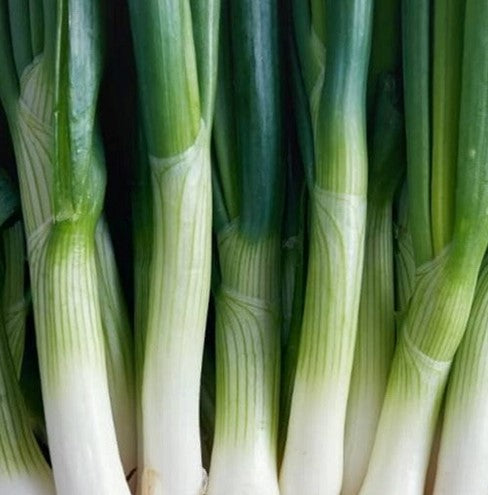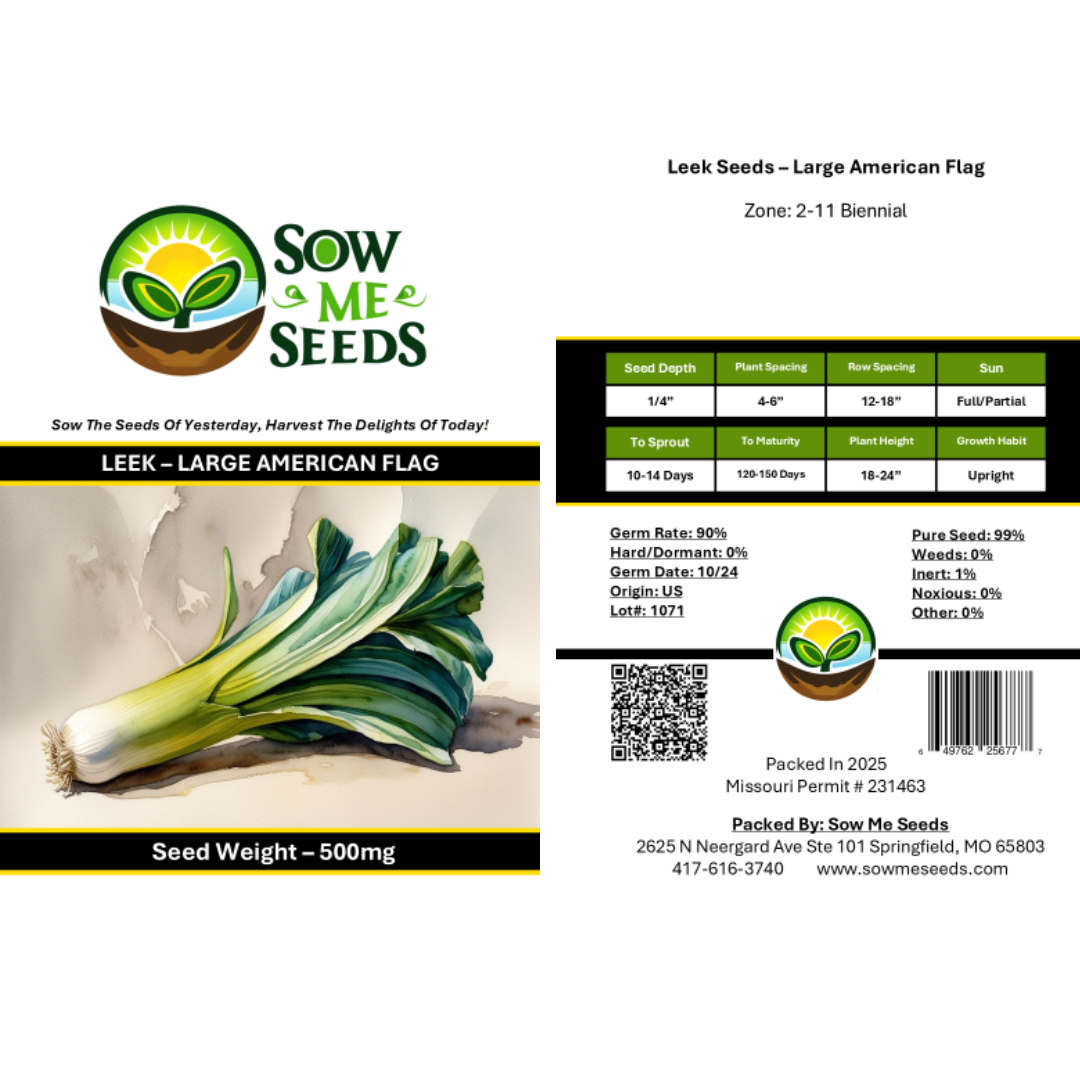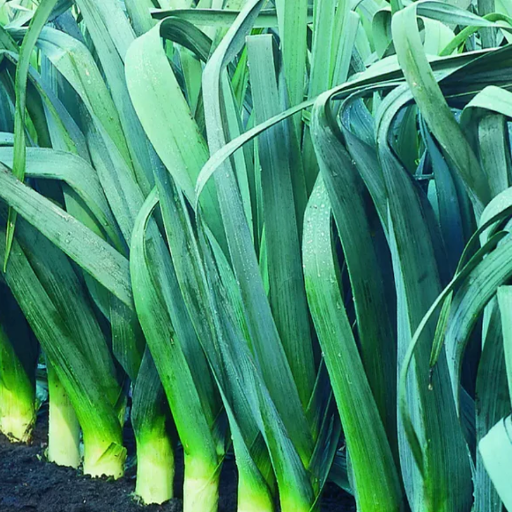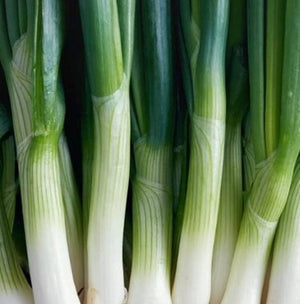- Hardiness Zone: 2-11 Biennial Typically Grown As An Annual
Seed Depth: 1/4 inch
Seed Spacing: 4–6 inches
Row Spacing: 12–18 inches
Sunlight: Full sun to partial shade
Days to Sprout: 10–14 days
Days to Maturity: 120–150 days
Growth Habit: Upright, hardy biennial (grown as an annual)
Sunlight: Thrives in full sun but tolerates partial shade, especially in hotter climates.
Soil Type: Prefers well-drained, fertile soil with a pH of 6.0–7.5. Enrich soil with compost for optimal growth.
When to Plant: Start seeds indoors 8–10 weeks before the last frost, or sow directly outdoors in early spring as soon as the soil is workable.
Direct Sowing: Plant seeds 1/4 inch deep and 4–6 inches apart in rows spaced 12–18 inches apart. Thin seedlings as needed.
Indoor Sowing: Start seeds in trays and transplant when seedlings are 6–8 inches tall. Bury stems deeply to promote long, white shafts.
Succession Planting: Stagger plantings every 2–3 weeks for a continuous harvest.
Watering: Water deeply and consistently, keeping the soil evenly moist but not waterlogged. Leeks prefer steady moisture for tender stalks.
Fertilizing: Apply a balanced fertilizer or compost at planting and during mid-season to support strong growth.
Blanching: As plants grow, mound soil or mulch around the stems to blanch them for long, tender, white stalks.
Pest and Disease Control: Monitor for onion maggots and rust. Use organic treatments or crop rotation to manage issues.
When to Harvest: Harvest when stems are 1–2 inches in diameter, typically 120–150 days after planting. Leeks can be harvested earlier for smaller, more tender stalks.
How to Harvest: Loosen soil around the base with a garden fork and gently pull plants. Avoid damaging stems during harvest.
Seed Collection: Allow some plants to overwinter and flower in their second year. Collect seeds from mature flower heads.
Storing Seeds: Dry seeds thoroughly and store them in an airtight container in a cool, dry place.
Why You’ll Love It
Mild and Sweet: Offers a more delicate, less pungent flavor than onions — perfect for gourmet cooking.
Cold Tolerant: Handles light frost and grows well into the cooler months.
Tall, Thick Stalks: Produces large, upright stems with creamy white bases and sturdy greens.
Long Harvest Window: Sow in spring and harvest from late summer through early winter.
Plant Characteristics
Height: 12–18 inches
Growth Habit: Upright with long, thick stalks and leafy tops
Stem Type: White, cylindrical shank with overlapping green leaves
Days to Maturity: 90–120 days
Hardiness: Biennial grown as an annual
Flavor and Culinary Uses
Flavor: Sweet, mild, and savory — less sharp than onions with a buttery finish
Culinary Uses: Perfect for soups, stews, gratins, roasts, and sautéed as a flavorful side
Companion Planting Tips
Good Companions: Carrots, celery, beets, and brassicas
Avoid Planting Near: Beans and peas (may compete for nutrients)
Bonus Benefit: Can be blanched by mounding soil around the base to extend the white stalk
Common Issues and Solutions
Thin Stalks: Transplant deeply and hill soil up around the base to promote thick shanks
Rust or Leaf Blight: Improve airflow and avoid overhead watering — remove affected foliage
Slow Growth: Feed with compost-rich soil and ensure consistent moisture
Seeds Per Packet
| 500mg | Approximately 160 |
| 3g | Approximately 960 |
Why You’ll Love It
Mild and Sweet: Offers a more delicate, less pungent flavor than onions — perfect for gourmet cooking.
Cold Tolerant: Handles light frost and grows well into the cooler months.
Tall, Thick Stalks: Produces large, upright stems with creamy white bases and sturdy greens.
Long Harvest Window: Sow in spring and harvest from late summer through early winter.
Plant Characteristics
Height: 12–18 inches
Growth Habit: Upright with long, thick stalks and leafy tops
Stem Type: White, cylindrical shank with overlapping green leaves
Days to Maturity: 90–120 days
Hardiness: Biennial grown as an annual
Flavor and Culinary Uses
Flavor: Sweet, mild, and savory — less sharp than onions with a buttery finish
Culinary Uses: Perfect for soups, stews, gratins, roasts, and sautéed as a flavorful side
Companion Planting Tips
Good Companions: Carrots, celery, beets, and brassicas
Avoid Planting Near: Beans and peas (may compete for nutrients)
Bonus Benefit: Can be blanched by mounding soil around the base to extend the white stalk
Common Issues and Solutions
Thin Stalks: Transplant deeply and hill soil up around the base to promote thick shanks
Rust or Leaf Blight: Improve airflow and avoid overhead watering — remove affected foliage
Slow Growth: Feed with compost-rich soil and ensure consistent moisture
Seeds Per Packet
| 500mg | Approximately 160 |
| 3g | Approximately 960 |





Share and get 15% off!
Simply share this product on one of the following social networks and you will unlock 15% off!